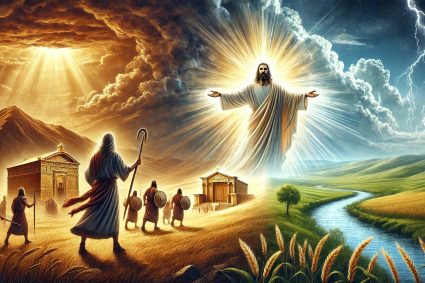


9.2 A Cursed Tree and a Cleansed Temple
Symbols of Divine Judgment
Read Mark 11:12–26. What is the significance of the events described here?
The events in Mark 11:12–26 are deeply symbolic and hold great significance for understanding Jesus’ message. The fig tree and the temple in this narrative are closely related and illustrate a sharp critique of the religious practices and spiritual state of Israel.
The fig tree, which has many leaves but no fruit, symbolizes the religious system of the temple and the religious leaders of that time. Outwardly, everything seemed fine—the temple operations were running at full throttle, and the religious leaders were in control. Yet, internally, the system was empty and fruitless, lacking the true fruit of faith and righteousness. Jesus curses the tree as a sign of the coming judgment upon the fruitless religious system.
The cleansing of the temple is a powerful act that underscores Jesus’ zeal for true worship of God and the purity of worship. By driving out the merchants and money changers, Jesus calls for a return to the original purpose of the temple as a “house of prayer for all nations” (Isaiah 56:7). However, the religious leaders had perverted this purpose through their greed and abuse of the system, turning the temple into a “den of robbers” (Jeremiah 7:11).
The connection between these two events—the withered fig tree and the cleansing of the temple—demonstrates that Jesus is delivering a radical critique of apparent piety without genuine spiritual fruit. It serves as a warning that outward religious practices are meaningless if they are not accompanied by a living faith and true obedience to God.
At the end of this narrative, Jesus teaches His disciples an important lesson about prayer and forgiveness. The withered fig tree serves as an example of the power of faith in prayer. At the same time, Jesus emphasizes that true worship and relationship with God always involve a readiness to forgive. These teachings are a call to inner purification and renewal of faith, away from outward appearances and empty ritualism.
Overall, this passage calls us to examine our own spiritual lives and ensure that our faith is not only outwardly visible but also inwardly fruitful, for the glory of God and the service of others.
What in your life needs to be cleansed by Jesus? How can this happen?
The question of what needs to be cleansed in our lives by Jesus is an invitation to deep self-reflection. Often, there are areas in our lives marked by sin, false priorities, or harmful habits. These can distance us from God and hinder our spiritual growth.
Perhaps there are areas in your life such as:
-
Unforgiveness or Bitterness: These can harden the heart and block the flow of God’s love and grace.
-
Selfishness or Pride: These lead us to focus more on ourselves than on God and others.
-
Fear and Doubt: These can weaken faith and prevent us from trusting and following God’s will.
-
Materialism or Addictions: These can distract us from the true treasures of life and push our relationship with God into the background.
To have these areas cleansed by Jesus, the first step is recognizing and admitting our weaknesses and sins. This is done through honest prayer, where we confess our faults and our need for His grace.
The next step is to actively bring these areas before God and ask for forgiveness and healing. This requires humility and a willingness to be transformed by God. It may also be helpful to seek support from spiritual communities that offer encouragement, prayer, and guidance.
Finally, it is important to trust in God’s guidance and actively take steps to leave behind old patterns. This could involve reading the Bible, regular prayer, attending worship services, or seeking spiritual counsel.
Allow Jesus to cleanse your heart and life by opening yourself to Him in prayer and dedication, being willing to leave behind old ways, and trusting in His plan for your life.
The events of the withered fig tree and the cleansing of the temple have a clear connection to our daily lives and faith. They challenge us to critically examine our spiritual lives and ensure that they are not only outwardly intact but also inwardly characterized by genuine fruit and spiritual depth.
-
Authenticity over Outward Appearances: In our daily lives, it is easy to fall into a routine of outward piety—regular church attendance, prayer, and religious rituals—without our hearts truly being filled with love, faith, and obedience to God. The withered fig tree symbolizes the danger of our lives appearing religious outwardly while bearing no inner fruit. This reminds us that God looks not just at the outside but at the inside, and our faith should be visible in genuine acts of love and righteousness.
-
Cleansing the “Temple” Within Us: The temple that Jesus cleansed was a place of worship that had been defiled by greed and false priorities. In our lives, there may be areas that need similar “cleansing”—whether it’s overcoming sin, letting go of false priorities, or seeking true devotion to God. Our hearts are often described as the “temple” of the Holy Spirit (1 Corinthians 6:19), and it is our responsibility to keep this temple pure and holy.
-
Prayer and Forgiveness as a Lifestyle: Jesus uses the withered fig tree to teach a lesson about the power of faith and the importance of forgiveness. These principles are crucial for our daily lives as Christians. A vibrant faith is demonstrated in trusting God’s power and goodness in every situation, while forgiveness helps us live free from bitterness and hatred. This challenges us to actively and regularly pray, trust God in all things, and both receive and extend forgiveness.
-
The Call to Self-Examination: Finally, these events call us to regularly examine our spiritual lives. Are we like the fig tree that bears no fruit or like a temple that has lost its true purpose? This self-examination helps us identify areas where we need to rededicate ourselves to God and take steps to grow in our relationship with Him.
The connection between these biblical stories and our daily lives carries a powerful message: Our faith should be not only visible but also authentic and fruitful, marked by true obedience, deep prayer, and a pure heart.
A fruitful faith is not shown in outward appearances but in the purity of the heart and the authenticity of our actions.
Visited 74 times, 1 visit(s) today








